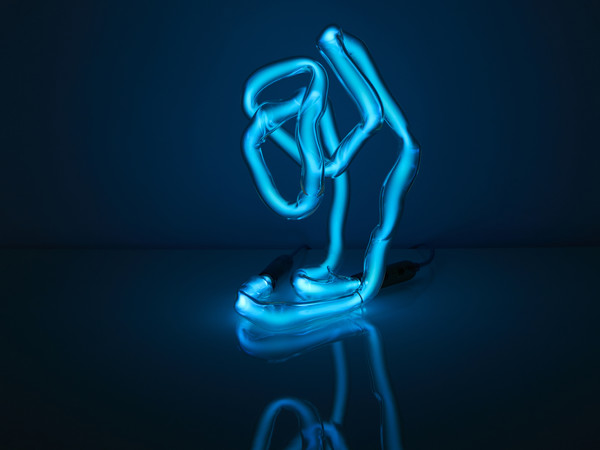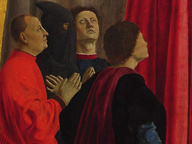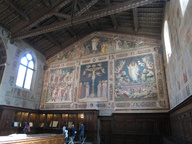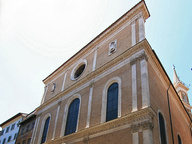The House Electric
From 17 Maggio 2018 to 11 Agosto 2018
Venice
Place: A plus A Gallery
Address: San Marco 3073
Times: 11 - 18 | Lun chiuso
Ticket price: Ingresso libero
Telefono per informazioni: +39 041 2770466
E-Mail info: info@aplusa.it
Official site: http://aplusa.it
head, neck, hair, ears, drop and tympan of the ears,
eyes, eye-fringes, iris of the eye, eyebrows, and the waking or sleeping of the lids,
Mouth, tongue, lips, teeth, roof of the mouth, jaws, and the jaw-hinges,
nose, nostrils of the nose, and the partition,
cheeks, temples, forehead, chin, throat, back of the neck, neck-slue,
strong shoulders, manly beard, scapula, hind-shoulders, and the ample side- round of the chest,
upper-arm, armpit, elbow-socket, lower-arm, arm-sinews, arm-bones,
Wrist and wrist-joints, hand, palm, knuckles, thumb, forefinger, finger- joints, finger-nails,
Broad breast-front, curling hair of the breast, breast-bone, breast-side,
ribs, belly, backbone, joints of the backbone,
hips, hip-sockets, hip-strength, inward and outward round, man-balls, man- root,
strong set of thighs, well carrying the trunk above,
leg fibres, knee, knee-pain, upper-leg, under-leg,
ankles, instep, foot-ball, toes, toe-joints, the heel;
all attitudes, all the shapeliness, all the belongings of my or your body or of any one’s body, male or female
Walt Whitman’s poem “I sing the body electric” from 1855 celebrates the human body as a primary agent through which we experience the world; soul and body are seen as equals. This show plays with these themes and applies them to the domestic. The House electric explores two fundamental elements: neon light and furniture.
Each exhibit shares aspects of the poems sensuality, equality and interconnectedness. The final part of the poem elaborates on
this with a lengthy list of body parts, some obvious ones, some obscure, internal or tiny. Verbs are stripped away, leaving objects to function as the main or in some cases only part in what becomes a direct and exposed structure.
Similarly, elements making up Richard Wheater’s neon installations give equal importance to its parts; the housing of
the transformer to celebrate the lights source, ‘umbilical’ electric wire encased in transparent glass. The light, a central concern of M-L-XL designs are to balance the constituent parts of a piece of furniture; legs, bends, joints, seat, surfaces, component colours, feet... nothing is hidden, a simple balance of all the necessary parts. Jochen Holz’s neon light installation and glass objects share an organic, bodily language, limb like flowing forms intestinal bulges, elbows knuckles and tubes, fluffy, cloud coloured light. The House electric: a collective approach in celebrating subtle variants in everyday familiar functionality. What we take for granted is to be unveiled in a new light!
Jochen Holz (UK)
His work is essentially rooted in his 25 year experience with glassblowing. While the making process is central to his practice
the work is not about a display of skill or techniques, but always guided by the immediacy and materiality of glass. Jochen’s biggest neon installation to date for A plus A Gallery brings together the research of the past few years into oversized borosilicate neon. With the increase in width of the tubing the light also takes on more physical qualities; the light emanates as a volume, rather than as the lines and contours of a traditional neon sign. The forms play with the light emitted by the different rare gases, the undulating tube subtly manipulates the light, softening and intensifying it in turns.
M–L–XL
Marco Campardo & Lorenzo Mason (ITA, UK)
Is an office for production and research across different disciplines, focusing on furniture, exhibitions, graphics, typography and publishing. The studio emerges from a collaborative practice founded in 2005 by Marco Campardo and Lorenzo Mason and focuses on extensive research, working through a plurality of languages, skills and knowledge. In the occasion of ‘The House electric’ the studio will show its last research on a furniture collection based on the use of an aluminium L profile. The research uses a common, everyday material to question the meaning of “innovation”, “novelty” and “experimentation” that is often emphasised in today’s design practice. The profiles are combined in different ways with joins that
are invisible, thus playing with the idea of materiality/immateriality and at the same time highlighting the overall construction of each object.
Richard Wheater (UK)
He is an artist using performance and installation to discuss our relationship with the natural environment. Output often remains loyal — but not exclusive to — his fascination with glass and neon, of which he performs and exhibits worldwide. He will show several new works of an industrial, functional aesthetic. Their aim is to describe neon and electricity as an object, whilst simultaneously suggesting links to human nature. Wheater is the founder of Neon Workshops, a company specializing in teaching and fabricating/installing neon.
eyes, eye-fringes, iris of the eye, eyebrows, and the waking or sleeping of the lids,
Mouth, tongue, lips, teeth, roof of the mouth, jaws, and the jaw-hinges,
nose, nostrils of the nose, and the partition,
cheeks, temples, forehead, chin, throat, back of the neck, neck-slue,
strong shoulders, manly beard, scapula, hind-shoulders, and the ample side- round of the chest,
upper-arm, armpit, elbow-socket, lower-arm, arm-sinews, arm-bones,
Wrist and wrist-joints, hand, palm, knuckles, thumb, forefinger, finger- joints, finger-nails,
Broad breast-front, curling hair of the breast, breast-bone, breast-side,
ribs, belly, backbone, joints of the backbone,
hips, hip-sockets, hip-strength, inward and outward round, man-balls, man- root,
strong set of thighs, well carrying the trunk above,
leg fibres, knee, knee-pain, upper-leg, under-leg,
ankles, instep, foot-ball, toes, toe-joints, the heel;
all attitudes, all the shapeliness, all the belongings of my or your body or of any one’s body, male or female
Walt Whitman’s poem “I sing the body electric” from 1855 celebrates the human body as a primary agent through which we experience the world; soul and body are seen as equals. This show plays with these themes and applies them to the domestic. The House electric explores two fundamental elements: neon light and furniture.
Each exhibit shares aspects of the poems sensuality, equality and interconnectedness. The final part of the poem elaborates on
this with a lengthy list of body parts, some obvious ones, some obscure, internal or tiny. Verbs are stripped away, leaving objects to function as the main or in some cases only part in what becomes a direct and exposed structure.
Similarly, elements making up Richard Wheater’s neon installations give equal importance to its parts; the housing of
the transformer to celebrate the lights source, ‘umbilical’ electric wire encased in transparent glass. The light, a central concern of M-L-XL designs are to balance the constituent parts of a piece of furniture; legs, bends, joints, seat, surfaces, component colours, feet... nothing is hidden, a simple balance of all the necessary parts. Jochen Holz’s neon light installation and glass objects share an organic, bodily language, limb like flowing forms intestinal bulges, elbows knuckles and tubes, fluffy, cloud coloured light. The House electric: a collective approach in celebrating subtle variants in everyday familiar functionality. What we take for granted is to be unveiled in a new light!
Jochen Holz (UK)
His work is essentially rooted in his 25 year experience with glassblowing. While the making process is central to his practice
the work is not about a display of skill or techniques, but always guided by the immediacy and materiality of glass. Jochen’s biggest neon installation to date for A plus A Gallery brings together the research of the past few years into oversized borosilicate neon. With the increase in width of the tubing the light also takes on more physical qualities; the light emanates as a volume, rather than as the lines and contours of a traditional neon sign. The forms play with the light emitted by the different rare gases, the undulating tube subtly manipulates the light, softening and intensifying it in turns.
M–L–XL
Marco Campardo & Lorenzo Mason (ITA, UK)
Is an office for production and research across different disciplines, focusing on furniture, exhibitions, graphics, typography and publishing. The studio emerges from a collaborative practice founded in 2005 by Marco Campardo and Lorenzo Mason and focuses on extensive research, working through a plurality of languages, skills and knowledge. In the occasion of ‘The House electric’ the studio will show its last research on a furniture collection based on the use of an aluminium L profile. The research uses a common, everyday material to question the meaning of “innovation”, “novelty” and “experimentation” that is often emphasised in today’s design practice. The profiles are combined in different ways with joins that
are invisible, thus playing with the idea of materiality/immateriality and at the same time highlighting the overall construction of each object.
Richard Wheater (UK)
He is an artist using performance and installation to discuss our relationship with the natural environment. Output often remains loyal — but not exclusive to — his fascination with glass and neon, of which he performs and exhibits worldwide. He will show several new works of an industrial, functional aesthetic. Their aim is to describe neon and electricity as an object, whilst simultaneously suggesting links to human nature. Wheater is the founder of Neon Workshops, a company specializing in teaching and fabricating/installing neon.
SCARICA IL COMUNICATO IN PDF
COMMENTI

-
 Dal 31 gennaio 2024 al 04 maggio 2025
Fermo | Palazzo dei Priori
Dal 31 gennaio 2024 al 04 maggio 2025
Fermo | Palazzo dei Priori
-
 Dal 20 dicembre 2024 al 04 maggio 2025
Fermo | Palazzo dei Priori
Dal 20 dicembre 2024 al 04 maggio 2025
Fermo | Palazzo dei Priori
-
 Dal 20 dicembre 2024 al 04 maggio 2024
Gorizia | Palazzo Attems Petzenstein
Dal 20 dicembre 2024 al 04 maggio 2024
Gorizia | Palazzo Attems Petzenstein
-
 Dal 18 dicembre 2024 al 18 dicembre 2024
Venezia | Museo Correr
Dal 18 dicembre 2024 al 18 dicembre 2024
Venezia | Museo Correr
-
 Dal 14 dicembre 2024 al 02 marzo 2025
Palermo | Palazzo Abatellis
Dal 14 dicembre 2024 al 02 marzo 2025
Palermo | Palazzo Abatellis
-
 Dal 12 dicembre 2024 al 23 febbraio 2025
Roma | Palazzo Altemps
Dal 12 dicembre 2024 al 23 febbraio 2025
Roma | Palazzo Altemps



